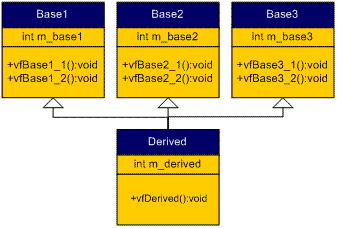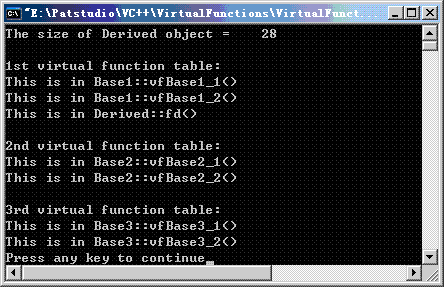内容概要:
满足下面3个条件时,
1. 父类有虚函数,子类也有虚函数,且子类的虚函数重写或覆盖了父类的虚函数
2. 非虚继承
3. 多重继承
类对象之内存布局
前篇: http://blog.csdn.net/pathuang68/archive/2009/04/23/4101981.aspx
多重继承,派生类不重写基类中的虚函数。
假定各类之间的关系如下图:
代码如下:
#include <iostream>
using namespace std;
class Base1
{
public:
int m_base1;
inline virtual void vfBase1_1()
{
cout << "This is in Base1::vfBase1_1()" << endl;
}
inline virtual void vfBase1_2()
{
cout << "This is in Base1::vfBase1_2()" << endl;
}
};
class Base2
{
public:
int m_base2;
inline virtual void vfBase2_1()
{
cout << "This is in Base2::vfBase2_1()" << endl;
}
inline virtual void vfBase2_2()
{
cout << "This is in Base2::vfBase2_2()" << endl;
}
};
class Base3
{
public:
int m_Base3;
inline virtual void vfBase3_1()
{
cout << "This is in Base3::vfBase3_1()" << endl;
}
inline virtual void vfBase3_2()
{
cout << "This is in Base3::vfBase3_2()" << endl;
}
};
class Derived : public Base1, public Base2, public Base3
{
public:
int m_derived;
inline virtual void fd()
{
cout << "This is in Derived::fd()" << endl;
}
};
typedef void (*VFun)(void);
template<typename T>
VFun virtualFunctionPointer(T* b, int i)
{
return (VFun)(*((int*)(*(int*)b) + i));
}
int main(void)
{
Derived d;
cout << "The size of Derived object = /t" << sizeof(Derived) << endl;
cout << endl;
cout << "1st virtual function table: " << endl;
int i = 0;
while(virtualFunctionPointer(&d, i))
{
VFun pVF = virtualFunctionPointer(&d, i++);
pVF();
}
cout << endl;
cout << "2nd virtual function table: " << endl;
i = 0;
int* tmp = ((int*)&d) + 2;
while(virtualFunctionPointer(tmp, i))
{
VFun pVF = virtualFunctionPointer(tmp, i++);
pVF();
}
cout << endl;
cout << "3rd virtual function table: " << endl;
i = 0;
tmp = ((int*)&d) + 4;
while(virtualFunctionPointer(tmp, i))
{
VFun pVF = virtualFunctionPointer(tmp, i++);
pVF();
}
return 0;
}
运行结果如下:
Derived对象之memory layout如下:

由上面的分析可知:
其一:有三个虚函数表
其二:在Derived类中定义的虚函数Derived::vfDerived()附加在一个虚函数表的最后
后篇:http://blog.csdn.net/pathuang68/archive/2009/04/23/4102002.aspx
























 1084
1084

 被折叠的 条评论
为什么被折叠?
被折叠的 条评论
为什么被折叠?








